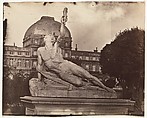Spartan Soldier
Charles Nègre French
Not on view
Astonished on first seeing daguerreotypes (about 1844) and dreaming of the medium's potential, Charles Nègre immediately resolved to devote himself to the new art, experimenting first with daguerreotypy and, after 1847, with paper photography. Like Le Secq and Le Gray, Nègre had studied painting with Paul Delaroche, and his experience at the easel was the foundation for his photographic work of the early 1850s--genre scenes of Parisian street musicians, chimney sweeps, and vendors, as well as architectural views.
Despite his acknowledged talent Nègre failed time and again either to win government support for or to bring to fruition the grand projects he envisioned for the new medium. Bypassed by the Commission des Monuments Historiques in the assignment of "missions héliographiques," Nègre produced some two hundred negatives for a self-initiated project entitled "Midi de la France," only to abandon the publication after issuing two fascicles. Frus trated in his effort to reap any financial benefit from his remarkable photogravure process, he proposed in 1858 that the city of Paris underwrite a 200- to 250-plate photogravure series on the appearance and history of the capital and that the Ministry of State commission a still larger project portraying "the history of humanity" through the collections of the Louvre. Neither proposal was accepted.
Finally gaining official sponsorship in 1859 for a series of fifty photogravures depicting statuary in the Tuileries Gardens, Nègre produced a group of large-format glass negatives. Characteristically, the project was stymied before completion, but a few unique prints of Nègre's heroic images survive, printed in reverse for translation into photogravure. Here, outlined against the theatrical backdrop of garden greenery and the central pavilion of the Tuileries Palace, Jean-Pierre Cortot's "Spartan Soldier" (1831) seems to rise toward the light. The fate of this soldier, who collapsed and died of exhaustion immediately after he had run to Athens to announce the rout of the Persian invaders at Marathon, seems an apt metaphor for Nègre's own foundering under the weight of his immense ability and ambition even as he heralded the triumphant potential of the medium. Nègre's unfulfilled project is among the last attempts at true artistry before the pressures of commercialism turned photography into a full-scale industry in the early 1860s.
Due to rights restrictions, this image cannot be enlarged, viewed at full screen, or downloaded.

